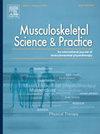Differences in non-weight-bearing and weight-bearing measures of lower leg muscle elasticity using shear wave elastography
IF 2.2
3区 医学
Q1 REHABILITATION
引用次数: 0
Abstract
Introduction
Elasticity is a biomechanical property of muscle necessary for physical function and can be measured with shear wave elastography (SWE). SWE may be useful in diagnosing pathology, predicting injury, and monitoring rehabilitation. This would be beneficial for smaller muscles working synergistically to resist external loads during functional activities. Establishing clinical measures of elasticity in larger sample sizes is necessary prior to its use in assessing pathology and guiding intervention.
Purpose
The study's primary aim was to investigate differences in elasticity for the tibialis anterior (TA), tibialis posterior (TP), peroneal longus (PL), and peroneal brevis (PB) muscles. It was hypothesized that there would be a statistically-significant difference in muscle elasticity both within and between non-weight-bearing (NWB) and weight-bearing (WB) positions.
Methods
Same-day, repeated-measures, cross-sectional design incorporating 109 healthy, recreationally active adults. Elasticity (kPa) was measured in NWB and 90 % WB.
Results
There was a statistically-significant interaction between muscle (TA, TP, PL, PB) and position (NWB, WB). Utilizing pairwise simple effects with Bonferroni correction, there was a significant (p ≤ 0.001–0.007) difference within muscles for NWB measures. WB measures revealed a significant (p ≤ 0.001) difference within muscles, except the TA-PB (p = 1.000). A significant (p ≤ 0.001–0.018) difference was found between NWB and WB positions for the TA, TP, and PB but not the PL (p = 0.140).
Conclusion
The utility of SWE may help describe how the biomechanical property of elasticity differs between resting positions and functional states of muscle contraction. These findings may aid future clinical applications of SWE for injury prevention, rehabilitation, and physical performance.
用横波弹性图测量非负重和负重下肢肌肉弹性的差异
弹性是肌肉的生理功能所必需的生物力学特性,可以用剪切波弹性成像(SWE)来测量。SWE可用于病理诊断、损伤预测和康复监测。这将有利于较小的肌肉协同工作,以抵抗外部负荷在功能活动。在评估病理和指导干预之前,有必要在更大的样本量中建立弹性的临床测量。目的研究胫骨前肌(TA)、胫骨后肌(TP)、腓骨长肌(PL)和腓骨短肌(PB)的弹性差异。假设在非负重(NWB)和负重(WB)体位内和体位之间的肌肉弹性存在统计学上显著的差异。方法对109名健康、有娱乐活动的成年人进行同一天、重复测量、横断面设计。在NWB和90% WB下测量弹性(kPa)。结果肌肉(TA、TP、PL、PB)与体位(NWB、WB)之间存在显著的交互作用。利用Bonferroni校正的两两简单效应,肌肉内NWB测量有显著差异(p≤0.001-0.007)。除TA-PB (p = 1.000)外,WB测量显示肌肉内差异显著(p≤0.001)。TA、TP和PB在NWB和WB位置之间有显著差异(p≤0.001 ~ 0.018),而PL在NWB和WB位置之间无显著差异(p = 0.140)。结论SWE的应用可能有助于描述肌肉在静止位置和收缩功能状态下弹性生物力学特性的差异。这些发现可能有助于未来SWE在损伤预防、康复和身体表现方面的临床应用。
本文章由计算机程序翻译,如有差异,请以英文原文为准。
求助全文
约1分钟内获得全文
求助全文
来源期刊

Musculoskeletal Science and Practice
Health Professions-Physical Therapy, Sports Therapy and Rehabilitation
CiteScore
4.10
自引率
8.70%
发文量
152
审稿时长
48 days
期刊介绍:
Musculoskeletal Science & Practice, international journal of musculoskeletal physiotherapy, is a peer-reviewed international journal (previously Manual Therapy), publishing high quality original research, review and Masterclass articles that contribute to improving the clinical understanding of appropriate care processes for musculoskeletal disorders. The journal publishes articles that influence or add to the body of evidence on diagnostic and therapeutic processes, patient centered care, guidelines for musculoskeletal therapeutics and theoretical models that support developments in assessment, diagnosis, clinical reasoning and interventions.
 求助内容:
求助内容: 应助结果提醒方式:
应助结果提醒方式:


